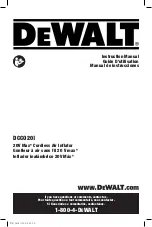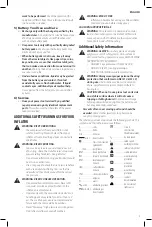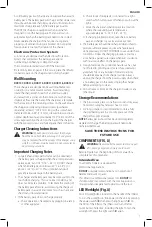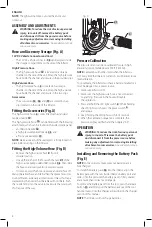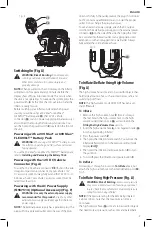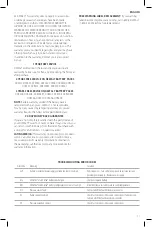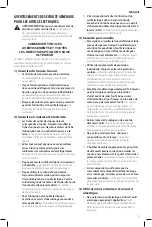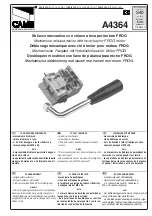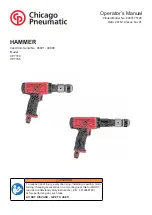
English
3
work to be performed.
Use of the power tool for
operations different from those intended could result
in a hazardous situation.
5) Battery Tool Use and Care
a )
Recharge only with the charger specified by the
manufacturer.
A charger that is suitable for one type
of battery pack may create a risk of fire when used
with another battery pack.
b )
Use power tools only with specifically designated
battery packs.
Use of any other battery packs may
create a risk of injury and fire.
c )
When battery pack is not in use, keep it away
from other metal objects, like paper clips, coins,
keys, nails, screws, or other small metal objects,
that can make a connection from one terminal to
another.
Shorting the battery terminals together may
cause burns or a fire.
d )
Under abusive conditions, liquid may be ejected
from the battery; avoid contact. If contact
accidentally occurs, flush with water. If liquid
contacts eyes, additionally seek medical help.
Liquid ejected from the battery may cause irritation
or burns.
6) Service
a )
Have your power tool serviced by a qualified
repair person using only identical replacement
parts.
This will ensure that the safety of the power
tool is maintained.
ADDITIONAL SAFETY WARNINGS FOR YOUR
INFLATOR
WARNING:
RISK TO BREATHING.
• The compressed air from your inflator is not
safe for breathing. Never inhale air from your
inflator or from a breathing device connected to
the inflator.
WARNING: RISK OF BURSTING.
• Too much air pressure causes a hazardous risk
of bursting. Check the manufacturer’s maximum
pressure rating for objects being inflated.
• Do not leave inflator running unattended. It could
burst tires or other items.
• Use a tire gauge to check the tires' pressure before
each use and while inflating tires; see the tire
sidewall and the vehicle manual for the correct
tire pressure.
WARNING: RISK OF UNSAFE OPERATION.
• Do not modify or attempt to repair. Never drill
into, weld, or make any modifications to the
inflator or its attachments.
• Operate only with the accessories included or air
handling parts acceptable for not less than 160
psi. The use of any accessory not recommended
for use with this tool could be hazardous.
• Never “horseplay.” High pressure air is dangerous.
Don’t direct air-flow at yourself or others.
WARNING: RISK OF FIRE:
• Inflator can become hot during use. Allow inflator
to cool 30 minutes before storing away.
CALIFORNIA PROPOSITION 65
WARNING:
This product or its power cord contains
lead, a chemical known to the State of California to
cause cancer and birth defects or other reproductive
harm. Wash hands after handling
Additional Safety Information
WARNING: ALWAYS
use safety glasses. Everyday
eyeglasses are NOT safety glasses. Also use face or
dust mask if cutting operation is dusty. ALWAYS WEAR
CERTIFIED SAFETY EQUIPMENT:
• ANSI Z87.1 eye protection (CAN/CSA Z94.3),
• ANSI S12.6 (S3.19) hearing protection,
• NIOSH/OSHA/MSHA respiratory protection.
WARNING: Always wear proper personal hearing
protection that conforms to ANSI S12.6 (S3.19)
during use.
Under some conditions and duration
of use, noise from this product may contribute to
hearing loss.
CAUTION: When not in use, place tool on its side
on a stable surface where it will not cause a
tripping or falling hazard.
Some tools with large
battery packs will stand upright on the battery pack
but may be easily knocked over.
•
Air vents often cover moving parts and should be
avoided.
Loose clothes, jewelry or long hair can be
caught in moving parts.
The label on your tool may include the following symbols. The
symbols and their definitions are as follows:
V ......................... volts
Hz .......................hertz
min .....................minutes
or DC ......direct current
...................... Class I Construction
(grounded)
…/min ..............per minute
BPM ....................beats per minute
IPM .....................impacts per minute
RPM .................... revolutions per
minute
sfpm ................... surface feet per
minute
SPM ....................strokes per minute
A .........................amperes
W ........................watts
or AC ...........alternating current
or AC/DC .... alternating or
direct current
...................... Class II
Construction
(double insulated)
no .......................no load speed
n .........................rated speed
......................earthing terminal
.....................safety alert symbol
.....................visible radiation
..................... wear respiratory
protection
..................... wear eye
protection
..................... wear hearing
protection
..................... read all
documentation
..................... do not stare at
light source
Summary of Contents for DCC020IB
Page 39: ......

